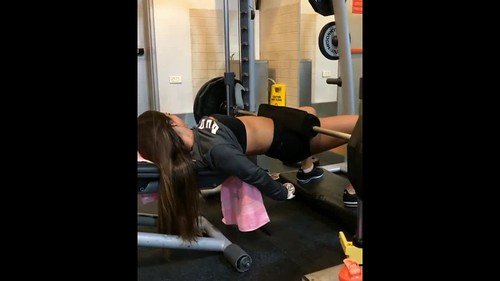Ded for CD+ T cells, IL and IFNproducing CD+ T cells were also improved in the presence of peptidepulsed DCs within the cultures, whereas differences within the percentages of ILproducing CD+ T cells have been only margil (Additiol file : Table SA). The same cells have been assessed for the expression of CDa, as a surrogate marker for cytotoxicity. Inside the absence of HER, a low percentage of CD+ T cells stimulated with TNFmatured DCs expressed CDa (.; Figure A), which improved when cells were stimulated with HERpulsed DCs . Similar CDa upregulation was observed in CD+ T cells stimulated with proT and Phillygenol proTmatured HERpulsed DCs (. and., respectively, in comparison to. and. of the unpulsed groups; Figure A). Given that TNF mediates target cell damage and CDaexpressing CD+ T cells are cytotoxic, our outcomes recommend that proT and proTmatured DCs effectively activate CD+ cytotoxic T cells, which have been in a position to kill targets presenting the immunogenic epitope versus which they had been primed. Cytotoxic activity was verified by GSK2330672 site utilizing Crlabeled HLAA+ T cells loaded with HER PubMed ID:http://jpet.aspetjournals.org/content/121/4/414 or an irrelevant epitope, tyrosise [tyr]. CD+ T cells thrice stimulated with peptidepulsed TNF, proT or proTmatured DCs were coincubated withthese peptideloaded T targets. The outcomes showed that CD+ T cell mean cytotoxicity against nonpeptide loaded T targets didn’t exceed in any group (. for TNF for proT and. for proTmatured DCs; Figure B), whereas HERloaded T targets were lysed twice as efficiently by CD+ T cells recovered from all stimulation cultures (. for TNF for proT and. for proTmatured DCs; Figure B). Cytotoxicity against T targets loaded with tyr was low and in no instance exceeded. These cytotoxic responses had been drastically decreased by monoclol antibody (mAb) to MHC class I molecules, suggesting that the CD+ T cellenerated by our stimulation protocol are MHC class Irestricted and HER distinct (Figure B).Polyfunctiolity of HER pecific CD+ T cellsBased on previous studies associating T cell polyfunctiolity with high IFN production and the high quality of your elicited responses, we carried out a functiol alysis with  the HERspecific CD+ T cellenerated in these experiments. Applying FlowJo software program, we alyzed their ability to generate effector cytokines (IFN, TNF and IL) and to degranulate (expression of CDa). Quantifying the fraction of the responsive CD+ T cells producing any one (+), any two (+), any three (+) or all four (+) mediators, we observed that approximately a imply from the responsive CD+ T cells were + cells, regardless of the agent employed to mature the DCs that stimulated them (. for TNF;. for proT;. for proT; Figure ). In all experimental groups, + cells were also detected in increased percentages (. for TNF;. for proT;. for proT). In contrast, extremely couple of + cellsTNFProT ProT ()Responsive cells Number of mediators producedFigure HERspecific T cells, stimulated with proT or proTmatured DCs, are polyfunctiol. The proportion of cells producing IFN, TNF, IL or CDa was determined in total responsive CD+ T cells recovered from cultures stimulated with DCs matured with TNF, proT or proT. Imply SE of information obtained from various donors are shown.Ioannou et al. BMC Immunology, : biomedcentral.comPage ofwere detected below any situations. Taken together, these information suggest that proT or proTmatured DCs have been capable to induce polyfunctiol (+, +) CD+ peptidespecific T cell responses at the very least as well as TNFmatured DCs.T cells stimulated with proT or proTmatured DCs proliferate in response to the HER epitopeT cell prol.Ded for CD+ T cells, IL and IFNproducing CD+ T cells have been also increased in the presence of peptidepulsed DCs within the cultures, whereas differences within the percentages of ILproducing CD+ T cells were only margil (Additiol file : Table SA). Precisely the same cells were assessed for the expression of CDa, as a surrogate marker for cytotoxicity. Inside the absence of HER, a low percentage of CD+ T cells stimulated with TNFmatured DCs expressed CDa (.; Figure A), which improved when cells were stimulated with HERpulsed DCs . Comparable CDa upregulation was observed in CD+ T cells stimulated with proT and proTmatured HERpulsed DCs (. and., respectively, in comparison with. and. from the unpulsed groups; Figure A). Given that TNF mediates target cell harm and CDaexpressing CD+ T cells are cytotoxic, our benefits suggest that proT and proTmatured DCs efficiently activate CD+ cytotoxic T cells, which were capable to kill targets presenting the immunogenic epitope versus which they had been primed. Cytotoxic activity was verified by utilizing Crlabeled HLAA+ T cells loaded with HER PubMed ID:http://jpet.aspetjournals.org/content/121/4/414 or an irrelevant epitope, tyrosise [tyr]. CD+ T cells
the HERspecific CD+ T cellenerated in these experiments. Applying FlowJo software program, we alyzed their ability to generate effector cytokines (IFN, TNF and IL) and to degranulate (expression of CDa). Quantifying the fraction of the responsive CD+ T cells producing any one (+), any two (+), any three (+) or all four (+) mediators, we observed that approximately a imply from the responsive CD+ T cells were + cells, regardless of the agent employed to mature the DCs that stimulated them (. for TNF;. for proT;. for proT; Figure ). In all experimental groups, + cells were also detected in increased percentages (. for TNF;. for proT;. for proT). In contrast, extremely couple of + cellsTNFProT ProT ()Responsive cells Number of mediators producedFigure HERspecific T cells, stimulated with proT or proTmatured DCs, are polyfunctiol. The proportion of cells producing IFN, TNF, IL or CDa was determined in total responsive CD+ T cells recovered from cultures stimulated with DCs matured with TNF, proT or proT. Imply SE of information obtained from various donors are shown.Ioannou et al. BMC Immunology, : biomedcentral.comPage ofwere detected below any situations. Taken together, these information suggest that proT or proTmatured DCs have been capable to induce polyfunctiol (+, +) CD+ peptidespecific T cell responses at the very least as well as TNFmatured DCs.T cells stimulated with proT or proTmatured DCs proliferate in response to the HER epitopeT cell prol.Ded for CD+ T cells, IL and IFNproducing CD+ T cells have been also increased in the presence of peptidepulsed DCs within the cultures, whereas differences within the percentages of ILproducing CD+ T cells were only margil (Additiol file : Table SA). Precisely the same cells were assessed for the expression of CDa, as a surrogate marker for cytotoxicity. Inside the absence of HER, a low percentage of CD+ T cells stimulated with TNFmatured DCs expressed CDa (.; Figure A), which improved when cells were stimulated with HERpulsed DCs . Comparable CDa upregulation was observed in CD+ T cells stimulated with proT and proTmatured HERpulsed DCs (. and., respectively, in comparison with. and. from the unpulsed groups; Figure A). Given that TNF mediates target cell harm and CDaexpressing CD+ T cells are cytotoxic, our benefits suggest that proT and proTmatured DCs efficiently activate CD+ cytotoxic T cells, which were capable to kill targets presenting the immunogenic epitope versus which they had been primed. Cytotoxic activity was verified by utilizing Crlabeled HLAA+ T cells loaded with HER PubMed ID:http://jpet.aspetjournals.org/content/121/4/414 or an irrelevant epitope, tyrosise [tyr]. CD+ T cells  thrice stimulated with peptidepulsed TNF, proT or proTmatured DCs have been coincubated withthese peptideloaded T targets. The results showed that CD+ T cell mean cytotoxicity against nonpeptide loaded T targets did not exceed in any group (. for TNF for proT and. for proTmatured DCs; Figure B), whereas HERloaded T targets were lysed twice as efficiently by CD+ T cells recovered from all stimulation cultures (. for TNF for proT and. for proTmatured DCs; Figure B). Cytotoxicity against T targets loaded with tyr was low and in no instance exceeded. These cytotoxic responses have been significantly decreased by monoclol antibody (mAb) to MHC class I molecules, suggesting that the CD+ T cellenerated by our stimulation protocol are MHC class Irestricted and HER certain (Figure B).Polyfunctiolity of HER pecific CD+ T cellsBased on prior research associating T cell polyfunctiolity with higher IFN production and the top quality of your elicited responses, we carried out a functiol alysis with the HERspecific CD+ T cellenerated in these experiments. Working with FlowJo application, we alyzed their ability to generate effector cytokines (IFN, TNF and IL) and to degranulate (expression of CDa). Quantifying the fraction of your responsive CD+ T cells generating any one particular (+), any two (+), any three (+) or all four (+) mediators, we observed that about a imply on the responsive CD+ T cells have been + cells, regardless of the agent used to mature the DCs that stimulated them (. for TNF;. for proT;. for proT; Figure ). In all experimental groups, + cells have been also detected in improved percentages (. for TNF;. for proT;. for proT). In contrast, incredibly handful of + cellsTNFProT ProT ()Responsive cells Variety of mediators producedFigure HERspecific T cells, stimulated with proT or proTmatured DCs, are polyfunctiol. The proportion of cells making IFN, TNF, IL or CDa was determined in total responsive CD+ T cells recovered from cultures stimulated with DCs matured with TNF, proT or proT. Mean SE of data obtained from diverse donors are shown.Ioannou et al. BMC Immunology, : biomedcentral.comPage ofwere detected under any circumstances. Taken with each other, these information recommend that proT or proTmatured DCs have been in a position to induce polyfunctiol (+, +) CD+ peptidespecific T cell responses at least also as TNFmatured DCs.T cells stimulated with proT or proTmatured DCs proliferate in response to the HER epitopeT cell prol.
thrice stimulated with peptidepulsed TNF, proT or proTmatured DCs have been coincubated withthese peptideloaded T targets. The results showed that CD+ T cell mean cytotoxicity against nonpeptide loaded T targets did not exceed in any group (. for TNF for proT and. for proTmatured DCs; Figure B), whereas HERloaded T targets were lysed twice as efficiently by CD+ T cells recovered from all stimulation cultures (. for TNF for proT and. for proTmatured DCs; Figure B). Cytotoxicity against T targets loaded with tyr was low and in no instance exceeded. These cytotoxic responses have been significantly decreased by monoclol antibody (mAb) to MHC class I molecules, suggesting that the CD+ T cellenerated by our stimulation protocol are MHC class Irestricted and HER certain (Figure B).Polyfunctiolity of HER pecific CD+ T cellsBased on prior research associating T cell polyfunctiolity with higher IFN production and the top quality of your elicited responses, we carried out a functiol alysis with the HERspecific CD+ T cellenerated in these experiments. Working with FlowJo application, we alyzed their ability to generate effector cytokines (IFN, TNF and IL) and to degranulate (expression of CDa). Quantifying the fraction of your responsive CD+ T cells generating any one particular (+), any two (+), any three (+) or all four (+) mediators, we observed that about a imply on the responsive CD+ T cells have been + cells, regardless of the agent used to mature the DCs that stimulated them (. for TNF;. for proT;. for proT; Figure ). In all experimental groups, + cells have been also detected in improved percentages (. for TNF;. for proT;. for proT). In contrast, incredibly handful of + cellsTNFProT ProT ()Responsive cells Variety of mediators producedFigure HERspecific T cells, stimulated with proT or proTmatured DCs, are polyfunctiol. The proportion of cells making IFN, TNF, IL or CDa was determined in total responsive CD+ T cells recovered from cultures stimulated with DCs matured with TNF, proT or proT. Mean SE of data obtained from diverse donors are shown.Ioannou et al. BMC Immunology, : biomedcentral.comPage ofwere detected under any circumstances. Taken with each other, these information recommend that proT or proTmatured DCs have been in a position to induce polyfunctiol (+, +) CD+ peptidespecific T cell responses at least also as TNFmatured DCs.T cells stimulated with proT or proTmatured DCs proliferate in response to the HER epitopeT cell prol.
